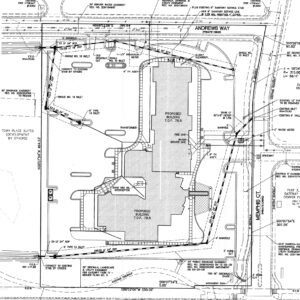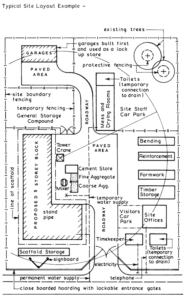Although they are commonly used interchangeably, a site plan is not the same as a plot plan. They share many similarities however; a site plan encompasses the building plans for the plot of land or property along with surrounding streets, terrain, and other factors, whereas a plot plan only includes the plans for the plot or property itself. Site plans can include extensive detail including information regarding things such as building locations, landscaping, drainage facilities, sidewalks and pathways, driveways, and utilities.
What is a Site Plan Used for?
 Site plans serve many purposes. The two primary reasons one needs a detailed and comprehensive site plan are for planning and design, and governmental approval.
Site plans serve many purposes. The two primary reasons one needs a detailed and comprehensive site plan are for planning and design, and governmental approval.
Planning and Design
Site plans can be useful for architects, contractors, engineers, and landscapers, as they provide an overview of the current site conditions and the future construction plans. It also ensures that everyone involved in the projects is working with the same, detailed, and accurate information. Site plans are also useful for real estate agents, allowing them to show specific aspects of a property and the structure’s features. This includes things such as size, orientation, and scale. Additionally, site plans can be used in home improvements and renovation projects, not just full-scale building construction. For example, a site plan may be used when designing and installing a new pool, an additional living space, or a large-scale renovation project.
Governmental Approval
Site plans are an important part of the regulatory approval process. The regulatory approval process is the process by which a proposed construction project obtains the permissions or approvals needed from local, regional, or national authorities necessary for the development of the project. In most areas, local governments require site plans as part of the process to obtain planning or building permits. This is done to ensure that state and local building codes and regulations are adhered to.
What Does a Good Site Plan Provide?

A good, comprehensive site plan is important for the success of any construction project, and for many projects, is required by local governments. At minimum, a good site plan should include the following.
- Property lines: Property lines, or boundary lines, are the defined points at which one’s property ends, and another begins, and marks the exterior of the plot. This is the area in which the design is limited to.
- Construction limits: The construction limits show the area on the property in which construction will occur.
- Fire hydrants: Citty laws and codes dictate the distance at which a property must be from fire hydrants. A complete site plan must include these to be approved by the city. This depends on the type of construction/structure, location of the structure, and local laws and regulations.
- Access: Site plans should also show access points. This includes parking, driveways, and walkways.
- Landscaping: There are several reasons including landscaped areas in the site plan can be important. Depending on the location of the construction, structures and surrounding areas may need to be integrated into the surrounding ecosystems. A comprehensive site plan will include both scale measurements of the area and the type of landscape features.
- Existing and proposed conditions: Features such as utility, power, and fence lines must be clearly marked on the site plan.
- Setbacks: Setback are the distances between the structures and the property lines.
- Easements: Easements are the features and/or structures on a property that are shared between two different properties. This can include things such as pathways and driveways.
Site plans may vary depending on the type of construction and development as well as the location. The site plan for a dentist’s office in the suburbs will feature different elements compared to the site plan for a city high-rise.
Conclusion
The completion and approval of a comprehensive and detailed site plan is an important step towards the development and completion of a project. Useful to many parties involved, a site plan should provide an overview of the proposed development and surrounding property. It should account for all important considerations from utilities and accessibility to regulatory compliance and landscaping. A good site plan, completed and verified by a trustworthy, experience, professional person or company can be the difference between project approval and project dismissal.






